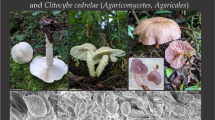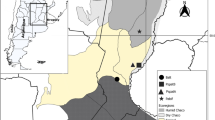Abstract
Though spirochetes have been repeatedly found in marine sponges and other invertebrates, little attention has been paid to the specificity of this association. This study demonstrates that different genoand morphotypes of spirochetes can reside within the same sponge individual and develop in considerable numbers. Specimens of the calcareous sponge Clathrina clathrus collected from the Adriatic Sea off Rovinj (Croatia) were found to harbor spirochete-like bacteria, which were characterized by scanning electron microscopy (SEM), 16S rRNA gene analysis, and catalyzed reporter deposition fluorescence in situ hybridization (CARD-FISH). Two novel spirochete sequence types related to the Brachyspiraceae could be retrieved. By use of specifically designed CARD-FISH probes, the C. clathrus-associated sequences could be assigned to a linear and a helical spirochete morphotype. Both were located within the sponge mesohyl and resembled the spirochete-like cells identified by SEM. In addition, from a Clathrina sp., most likely C. coriacea, that originated from Indonesian coastal waters, four different spirochete type sequences were recovered. Two of these also affiliated with the Brachyspiraceae, the other two were found associated with the Spirochaetaceae, one with the genera Borrelia and Cristispira.
Similar content being viewed by others
References
Altschul, S.F., W. Gish, W. Miller, E.W. Myers, and D.J. Lipman. 1990. Basic local alignment search tool. J. Mol. Biol. 215, 403–410.
Bosshard, P.P., S. Abels, R. Zbinden, E.C. Böttger, and M. Altwegg. 2003. Ribosomal DNA sequencing for identification of aerobic Gram-positive rods in the clinical laboratory (an 18-month evaluation). J. Clin. Microbiol. 41, 4134–4140.
Boury-Esnault, N., L. De Vos, C. Donadey, and J. Vacelet. 1984. Comparative study of the choanosome of Porifera: I. The Homoscleromorpha. J. Morphol. 180, 3–17.
Canale-Parola, E., Z. Udris, and M. Mandel. 1968. The classification of free-living spirochetes. Arch. Microbiol. 63, 385–397.
Cardenas, E., W.M. Wu, M.B. Leigh, J. Carley, S. Carroll, T. Gentry, J. Luo, and et al. 2008. Microbial communities in contaminated sediments, associated with bioremediation of uranium to submicromolar levels. Appl. Environ. Microbiol. 74, 3718–3729.
Dewhirst, F.E., M.A. Tamer, R.E. Ericson, C.N. Lau, V.A. Levanos, S.K. Boches, J.L. Galvin, and B.J. Paster. 2000. The diversity of periodontal spirochetes by 16S rRNA analysis. Oral Microbiol. Immun. 15, 196–202.
Evans, N.J., J.M. Brown, I. Demirkan, R.D. Murray, W.D. Vink, R.W. Blowey, C.A. Hart, and S.D. Carter. 2008. Three unique groups of spirochetes isolated from digital dermatitis lesions in UK cattle. Vet. Microbiol. 130, 141–150.
Felsenstein, J. 1989. PHYLIP-Phylogeny Inference Package (Version 3.2). Cladistics 5, 164–166.
Friedrich, A.B., I. Fischer, P. Proksch, J. Hacker, and U. Hentschel. 2001. Temporal variation of the microbial community associated with the Mediterranean sponge Aplysina aerophoba. FEMS Microbiol. Ecol. 38, 105–113.
Gerçe, B., T. Schwartz, M. Voigt, S. Rühle, S. Kirchen, A. Putz, P. Proksch, U. Obst, C. Syldatk, and R. Hausmann. 2009. Morphological, bacterial, and secondary metabolite changes of Aplysina aerophoba upon long-term maintenance under artificial conditions. Microb. Ecol. 58, 865–878.
Grabowski, V. 2002. Nachweis und Charakterisierung von Actinobakterien und einigen Planktomycetales aus marinen Schwämmen. Ph.D. Christian-Albrechts-Universität, Kiel, Germany.
Guindon, S. and O. Gascuel. 2003. A simple, fast, and accurate algorithm to estimate large phylogenies by maximum likelihood. Syst. Biol. 52, 696–704.
Guner, E.S., M. Watanabe, N. Hashimoto, T. Kadosaka, Y. Kawamura, T. Ezaki, H. Kawabata, Y. Imai, K. Kaneda, and T. Masuzawa. 2004. Borrelia turcica sp. nov., isolated from the hard tick Hyalomma aegyptium in Turkey. Int. J. Syst. Evol. Microbiol. 54, 1649–1652.
Hentschel, U., L. Fieseler, M. Wehrl, C. Gernert, M. Steinert, J. Hacker, and M. Horn. 2003. Microbial diversity of marine sponges, pp. 60–88. In W.E.G. Müller (ed.), Molecular marine biology of sponges, Springer-Verlag, Heidelberg, Germany.
Hentschel, U., J. Hopke, M. Horn, A.B. Friedrich, M. Wagner, J. Hacker, and B.S. Moore. 2002. Molecular evidence for a uniform microbial community in sponges from different oceans. Appl. Environ. Microbiol. 68, 4431–4440.
Hentschel, U., K.M. Usher, and M.W. Taylor. 2006. Marine sponges as microbial fermenters. FEMS Microbiol. Ecol. 55, 167–177.
Hill, M., A. Hill, N. Lopez, and O. Harriott. 2006. Sponge-specific bacterial symbionts in the Caribbean sponge, Chondrilla nucula (Demospongiae, Chondrosida). Mar. Biol. 148, 1221–1230.
Imhoff, J.F. and R. Stöhr. 2003. Sponge-associated bacteria: general overview and special aspects of bacteria associated with Halichondria panicea, pp. 35–56. In W.E.G. Müller (ed.), Molecular marine biology of sponges, Springer-Verlag, Heidelberg, Germany.
Isaacs, L., J. Kan, L. Nguyen, P. Videau, M. Anderson, T. Wright, and R. Hill. 2009. Comparison of the bacterial communities of wild and captive sponge Clathria prolifera from the Chesapeake Bay. Mar. Biotechnol. 11, 758–770.
Keane, T.M., C.J. Creevey, M.M. Pentony, T.J. Naughton, and J.O. McInerney. 2006. Assessment of methods for amino acid matrix selection and their use on empirical data shows that ad hoc assumptions for choice of matrix are not justified. BMC Evol. Biol. 6, 29.
Kulikova, T., P. Aldebert, N. Althorpe, W. Baker, K. Bates, P. Browne, A. van den Broek, and et al. 2004. The EMBL nucleotide sequence database. Nucleic Acids Res. 32, 27–30.
Loy, A., R. Arnold, P. Tischler, T. Rattei, M. Wagner, and M. Horn. 2008. probeCheck - a central resource for evaluating oligonucleotide probe coverage and specificity. Environ. Microbiol. 10, 2894–2898.
Ludwig, W., O. Strunk, R. Westram, L. Richter, H. Meier, Yadhukumar, A. Buchner, and et al. 2004. ARB: a software environment for sequence data. Nucleic Acids Res. 32, 1363–1371.
Margulis, L. and G. Hinkle. 1992. Large symbiotic spirochetes: Clevelandina, Cristispira, Diplocalyx, Hollandina, and Pillotina, pp. 3965–3978. In A. Balows, H.G. Trüper, M. Dworkin, W. Harder, and K.H. Schleifer (eds.), The prokaryotes, Springer, New York, N.Y., USA.
Masuzawa, T., N. Takada, M. Kudeken, T. Fukui, Y. Yano, F. Ishiguro, Y. Kawamura, Y. Imai, and T. Ezaki. 2001. Borrelia sinica sp. nov., a lyme disease-related Borrelia species isolated in China. Int. J. Syst. Evol. Microbiol. 51, 1817–1824.
Mohamed, N.M., J.J. Enticknap, J.E. Lohr, S.M. McIntosh, and R.T. Hill. 2008a. Changes in bacterial communities of the marine sponge Mycale laxissima on transfer into aquaculture. Appl. Environ. Microbiol. 74, 1209–1222.
Mohamed, N.M., V. Rao, M.T. Hamann, M. Kelly, and R.T. Hill. 2008b. Monitoring bacterial diversity of the marine sponge Ircinia strobilina upon transfer into aquaculture. Appl. Environ. Microbiol. 74, 4133–4143.
Neulinger, S.C., A. Gärtner, J. Järnegren, M. Ludvigsen, K. Lochte, and W.C. Dullo. 2009. Tissue-associated “Candidatus Mycoplasma corallicola” and filamentous bacteria on the cold-water coral Lophelia pertusa (Scleractinia). Appl. Environ. Microbiol. 75, 1437–1444.
Neulinger, S.C., J. Järnegren, M. Ludvigsen, K. Lochte, and W.C. Dullo. 2008. Phenotype-specific bacterial communities in the coldwater coral Lophelia pertusa (Scleractinia) and their implications for the coral’s nutrition, health, and distribution. Appl. Environ. Microbiol. 74, 7272–7285.
Noguchi, H. 1921. Cristispira in North American shellfish. A note on a spirillum found in oysters. J. Exp. Med. 34, 295–315.
Nordhoff, M., D. Taras, M. Macha, K. Tedin, H.J. Busse, and L.H. Wieler. 2005. Treponema berlinense sp. nov. and Treponema porcinum sp. nov., novel spirochaetes isolated from porcine faeces. Int. J. Syst. Evol. Microbiol. 55, 1675–1680.
Pruesse, E., C. Quast, K. Knittel, B.M. Fuchs, W. Ludwig, J. Peplies, and F.O. Glöckner. 2007. SILVA: a comprehensive online resource for quality checked and aligned ribosomal RNA sequence data compatible with ARB. Nucleic Acids Res. 35, 7188–7196.
Schirmer, A., R. Gadkari, C.D. Reeves, F. Ibrahim, E.F. DeLong, and C.R. Hutchinson. 2005. Metagenomic analysis reveals diverse polyketide synthase gene clusters in microorganisms associated with the marine sponge Discodermia dissoluta. Appl. Environ. Microbiol. 71, 4840–4849.
Stackebrandt, E. and J. Ebers. 2006. Taxonomic parameters revisited: tarnished gold standards. Microbiol. Today 33, 152–155.
Taylor, M.W., R. Radax, D. Steger, and M. Wagner. 2007. Sponge-associated microorganisms: evolution, ecology, and biotechnological potential. Microbiol. Mol. Biol. R. 71, 295–347.
Thiel, V., S. Leininger, R. Schmaljohann, F. Brümmer, and J.F. Imhoff. 2007a. Sponge-specific bacterial associations of the Mediterranean sponge Chondrilla nucula (Demospongiae, Tetractinomorpha). Microb. Ecol. 54, 101–111.
Thiel, V., S.C. Neulinger, T. Staufenberger, R. Schmaljohann, and J.F. Imhoff. 2007b. Spatial distribution of sponge-associated bacteria in the Mediterranean sponge Tethya aurantium. FEMS Microbiol. Ecol. 59, 47–63.
Thoms, C., M. Horn, M. Wagner, U. Hentschel, and P. Proksch. 2003. Monitoring microbial diversity and natural product profiles of the sponge Aplysina cavernicola following transplantation. Mar. Biol. 142, 685–692.
Vacelet, J., N. Boury-Esnault, L. De Vos, and C. Donadey. 1989. Comparative study of the choanosome of Porifera: II. The keratose sponges. J. Morphol. 201, 119–129.
Wang, G.Y. 2006. Diversity and biotechnological potential of the sponge-associated microbial consortia. J. Ind. Microbiol. Biotechnol. 33, 545–551.
Yilmaz, L.S. and D.R. Noguera. 2004. Mechanistic approach to the problem of hybridization efficiency in fluorescent in situ hybridization. Appl. Environ. Microbiol. 70, 7126–7139.
Yilmaz, L.S., H.E. Okten, and D.R. Noguera. 2006. Making all parts of the 16S rRNA of Escherichia coli accessible in situ to single DNA oligonucleotides. Appl. Environ. Microbiol. 72, 733–744.
Zhilina, T.N., G.A. Zavarzin, F. Rainey, V.V. Kevbrin, N.A. Kostrikina, and A.M. Lysenko. 1996. Spirochaeta alkalica sp. nov., Spirochaeta africana sp. nov., and Spirochaeta asiatica sp. nov., alkaliphilic anaerobes from the continental soda lakes in Central Asia and the East African Rift. Int. J. Syst. Bacteriol. 46, 305–312.
Author information
Authors and Affiliations
Corresponding author
Additional information
Supplemental material for this article may be found at http://www.springer.com/content/120956
Electronic supplementary material
Rights and permissions
About this article
Cite this article
Neulinger, S.C., Stöhr, R., Thiel, V. et al. New phylogenetic lineages of the Spirochaetes phylum associated with Clathrina species (Porifera). J Microbiol. 48, 411–418 (2010). https://doi.org/10.1007/s12275-010-0017-x
Received:
Accepted:
Published:
Issue Date:
DOI: https://doi.org/10.1007/s12275-010-0017-x




